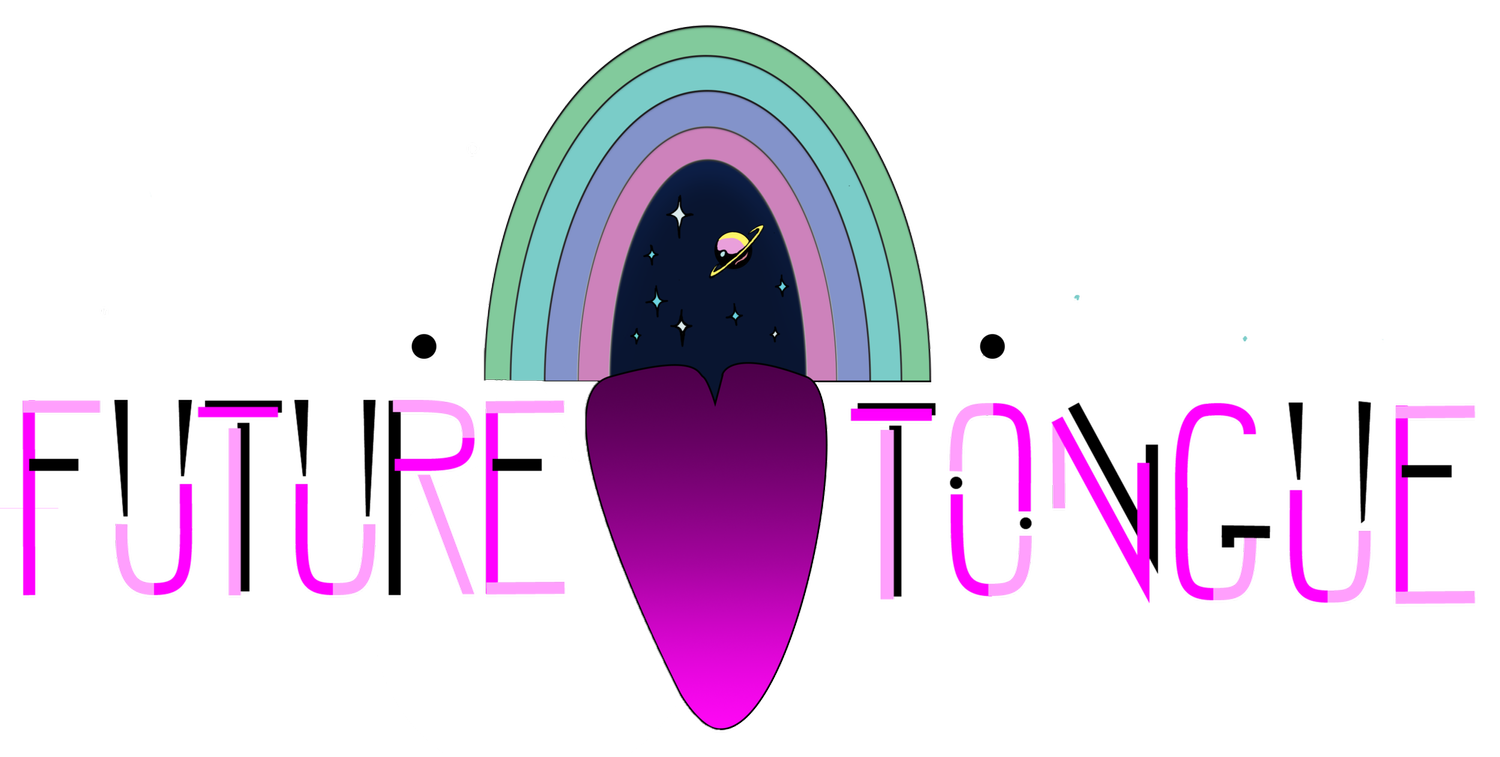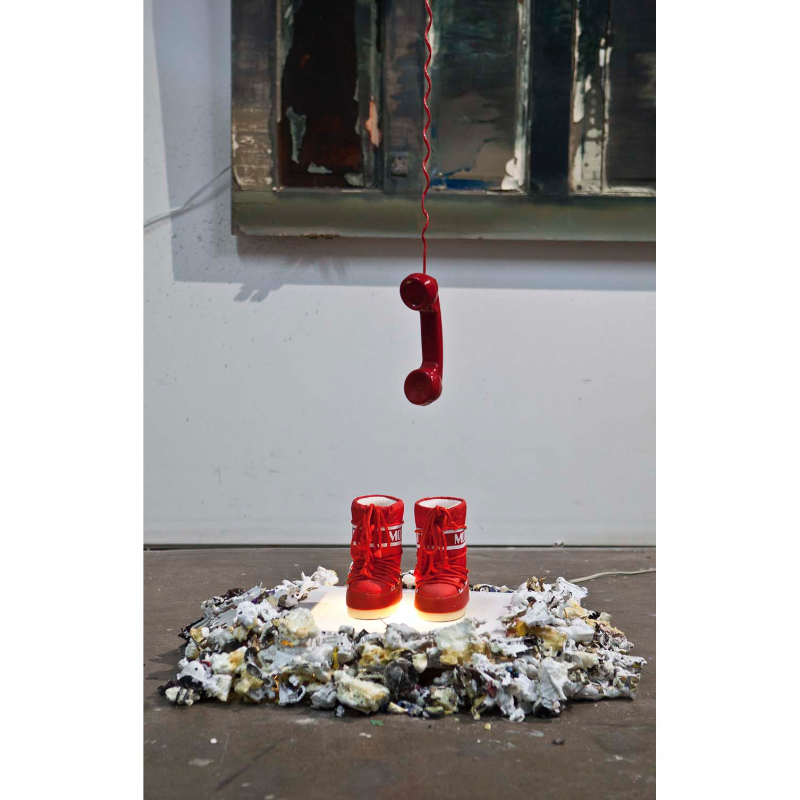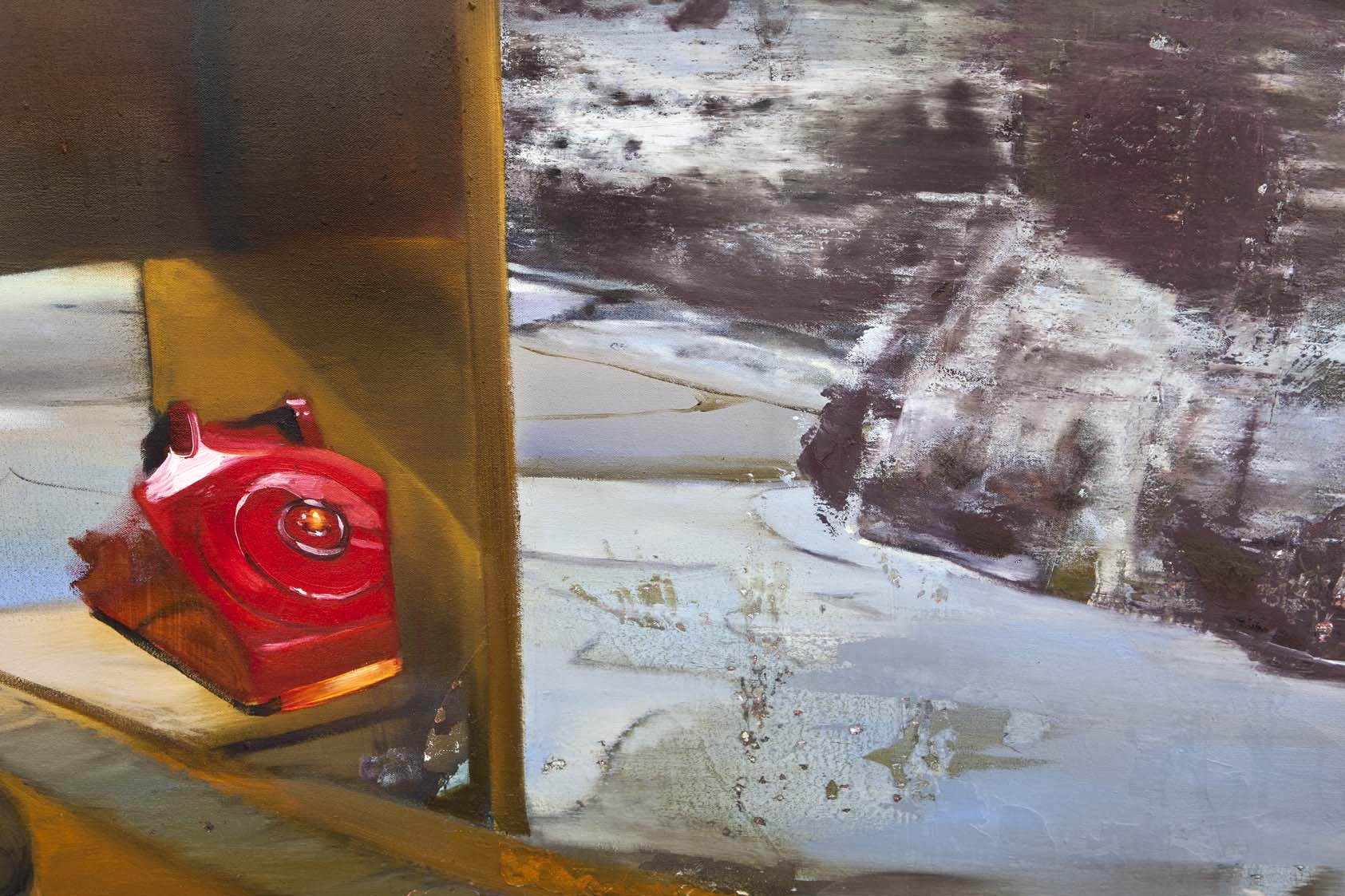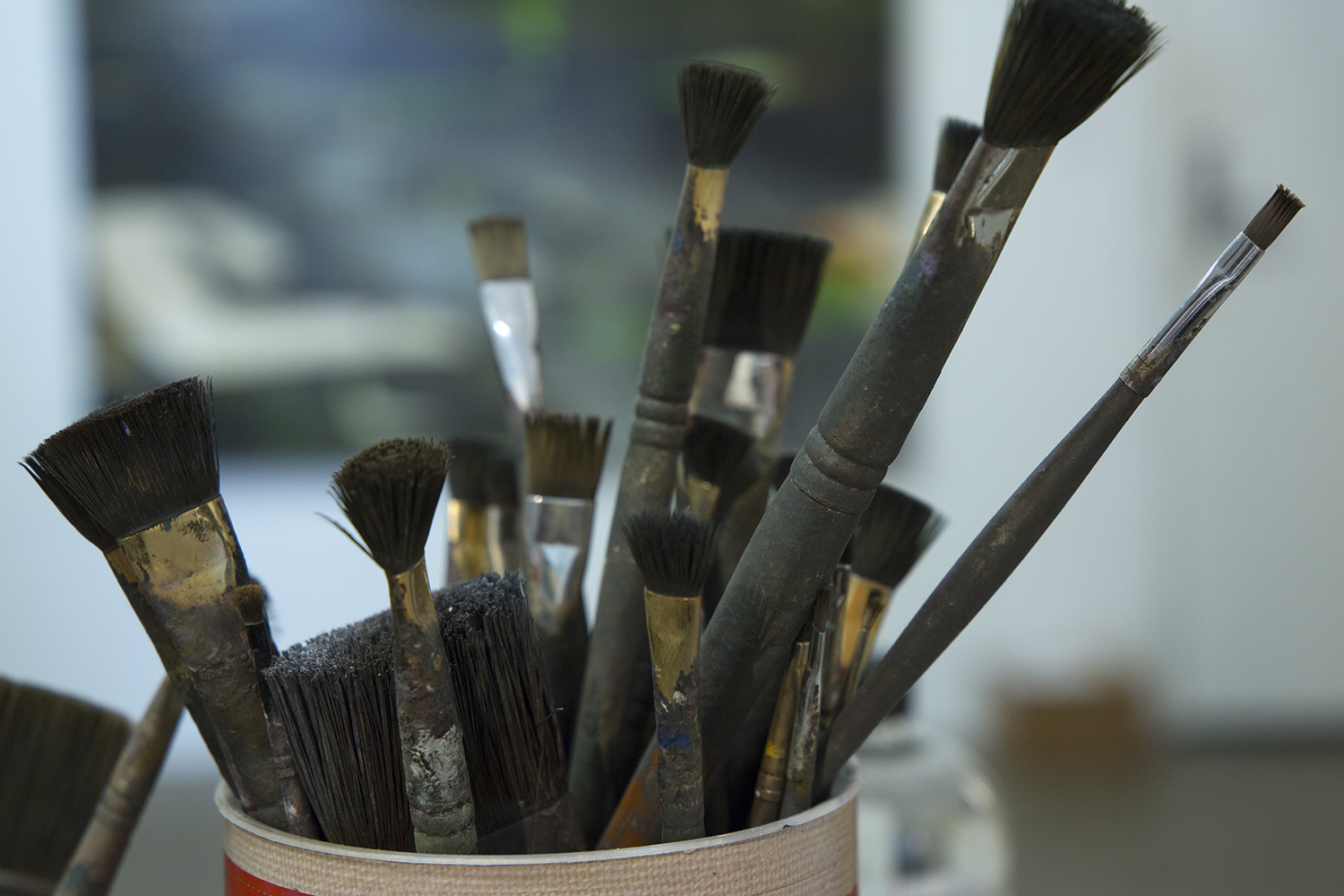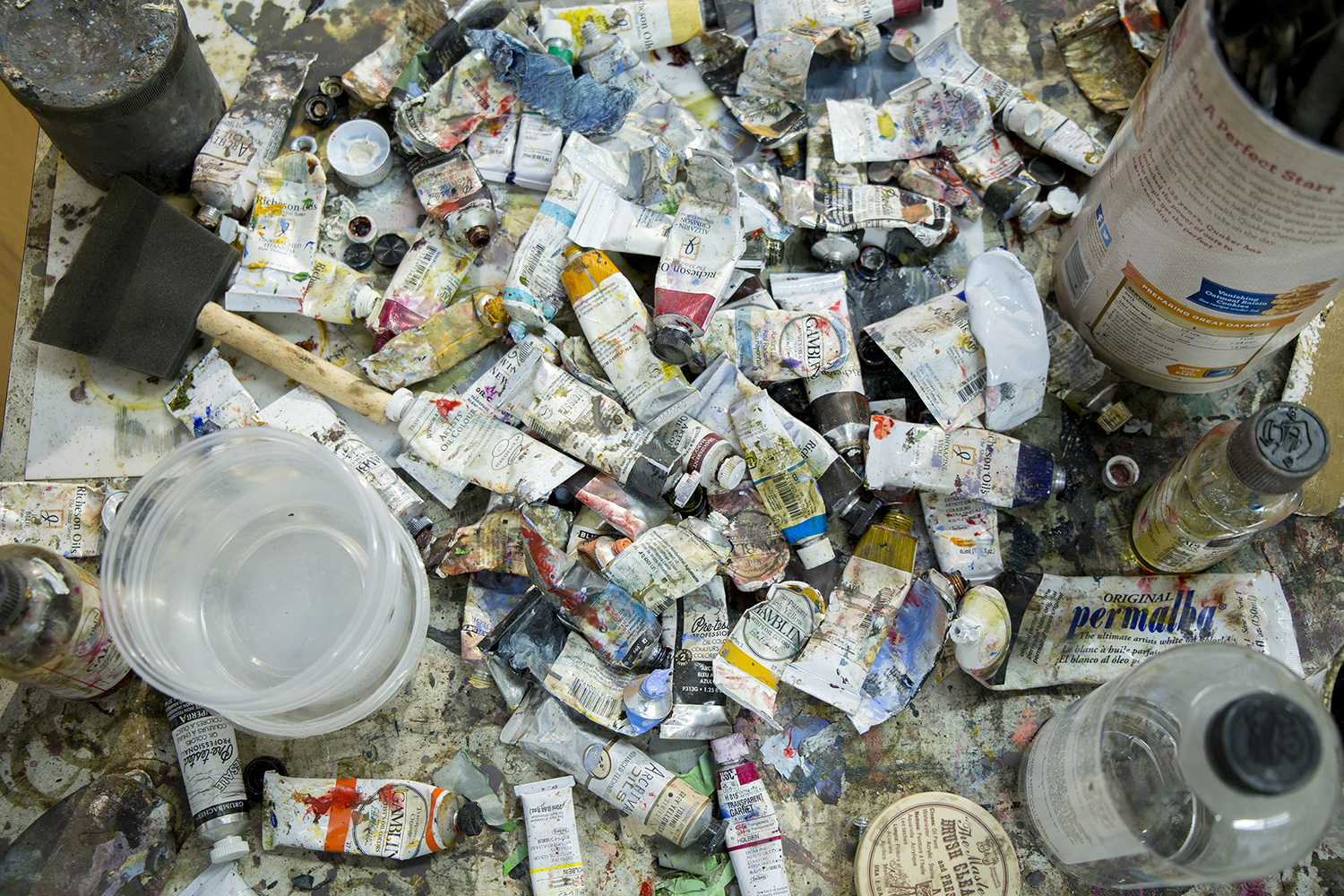
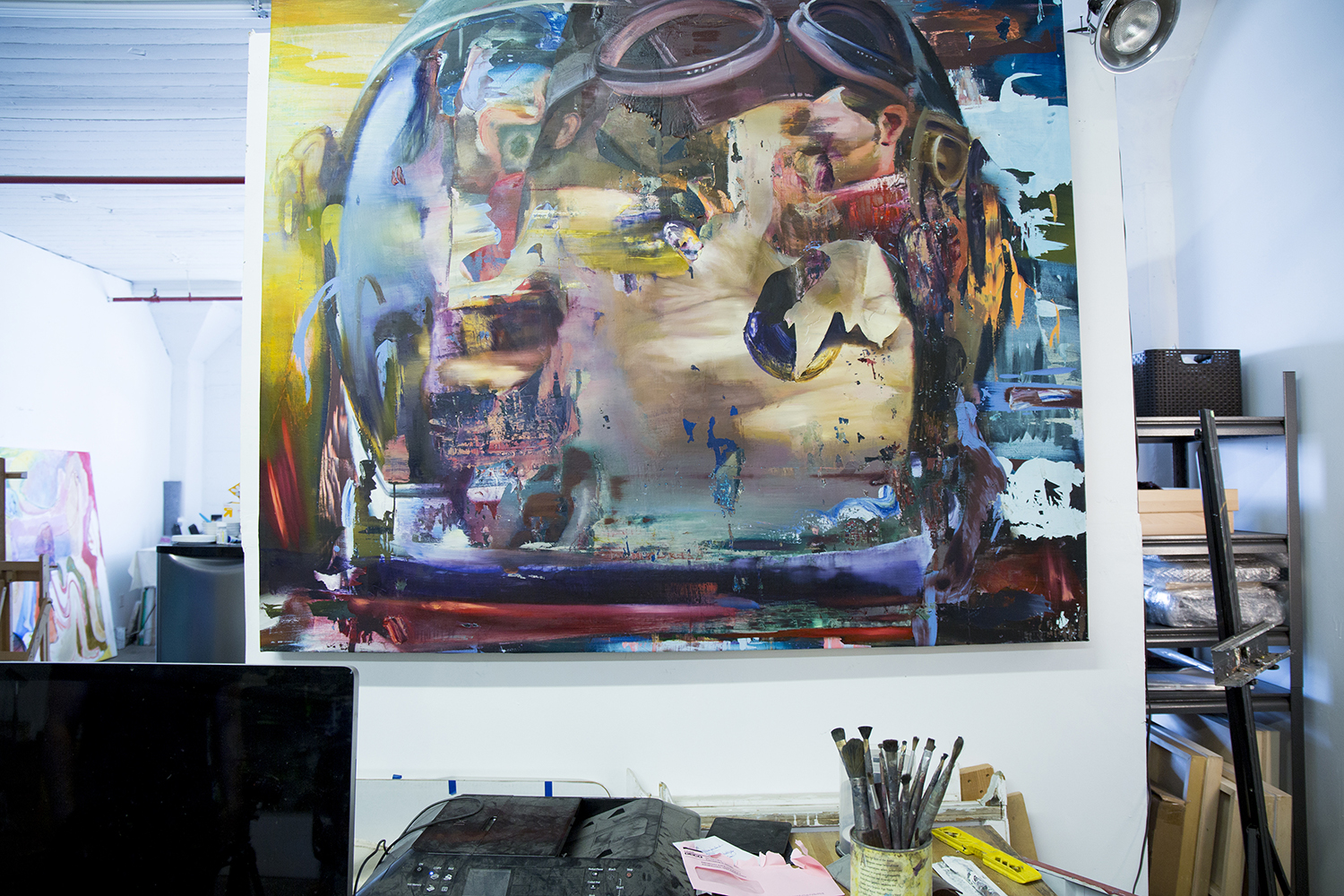
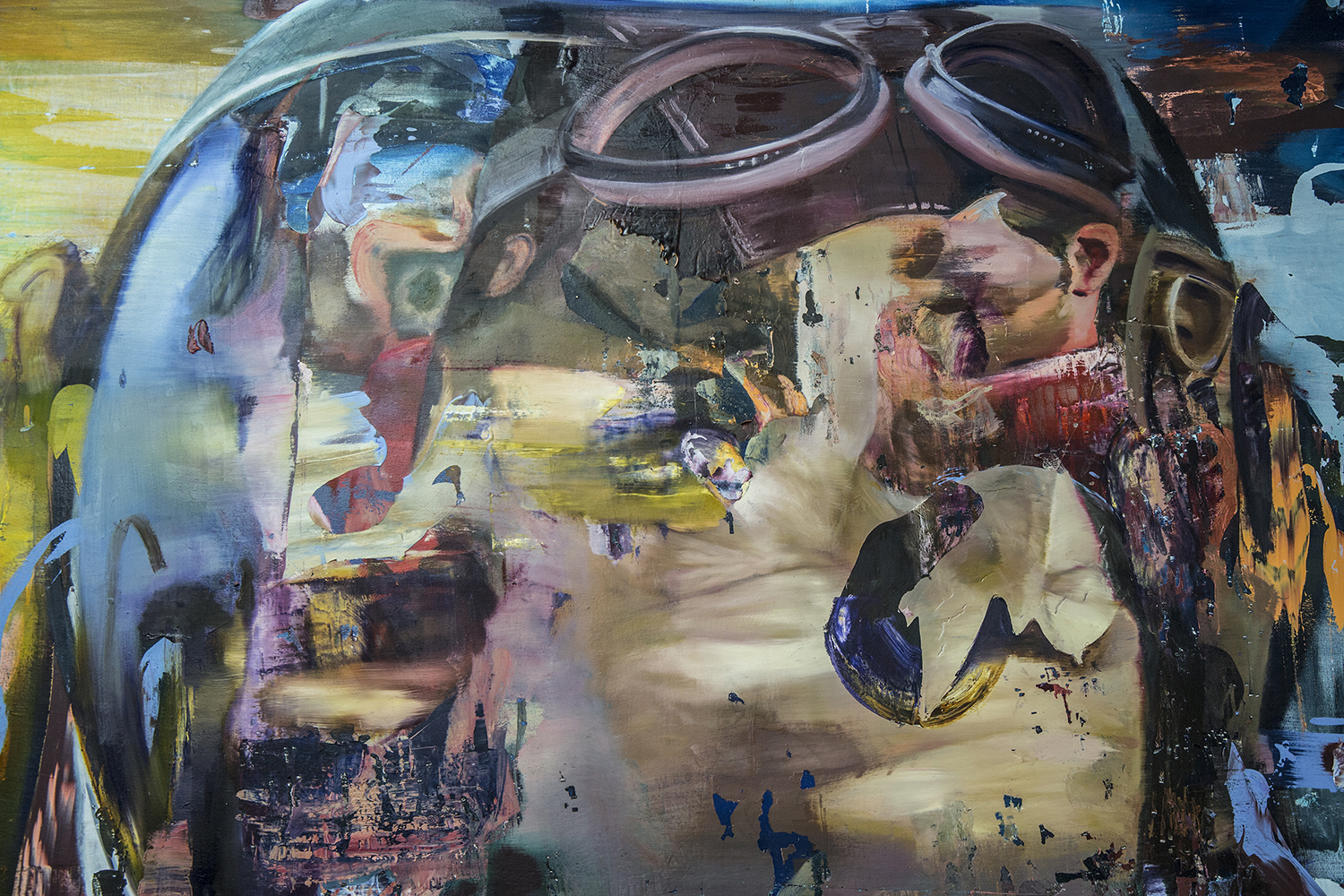
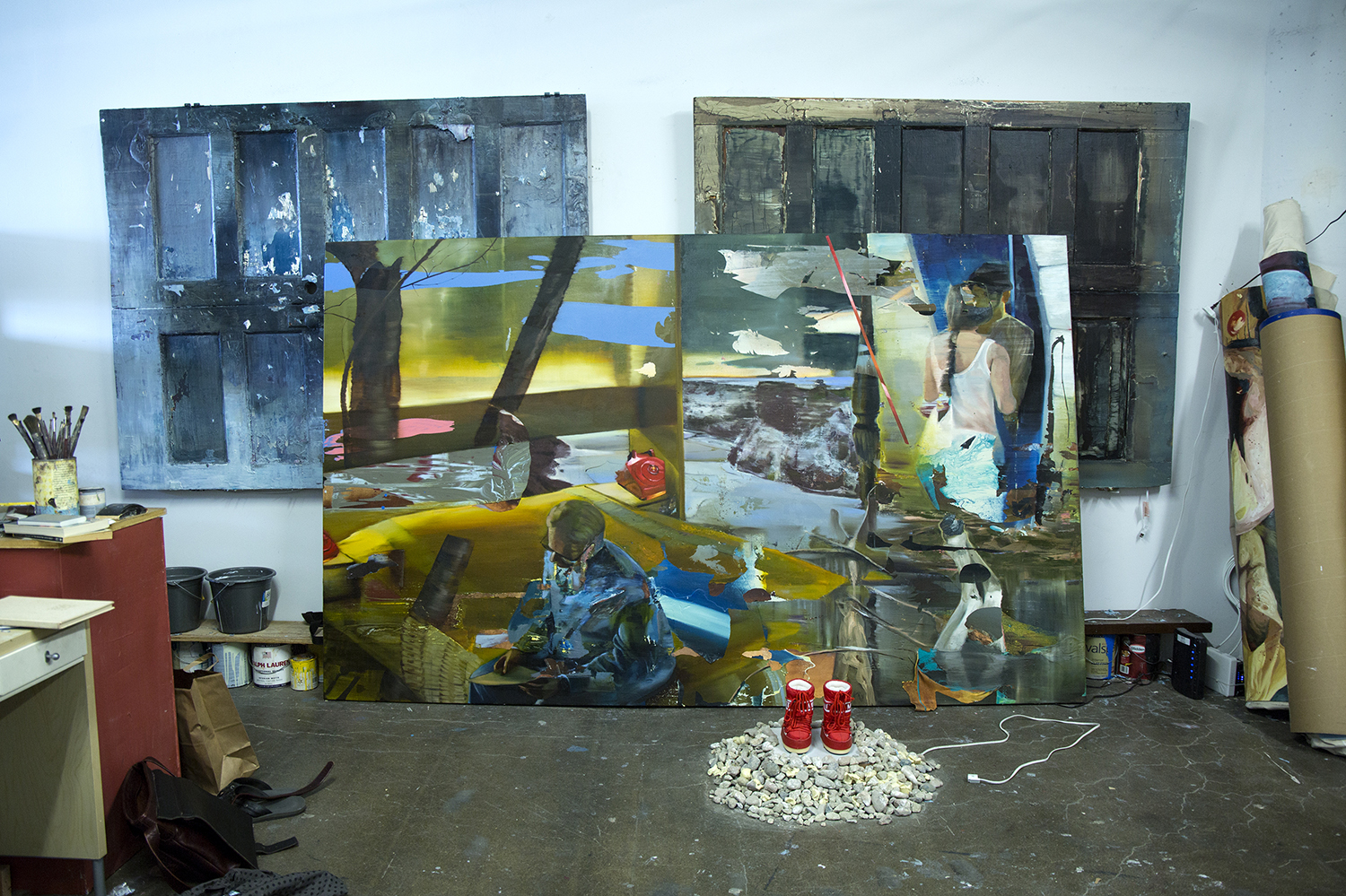
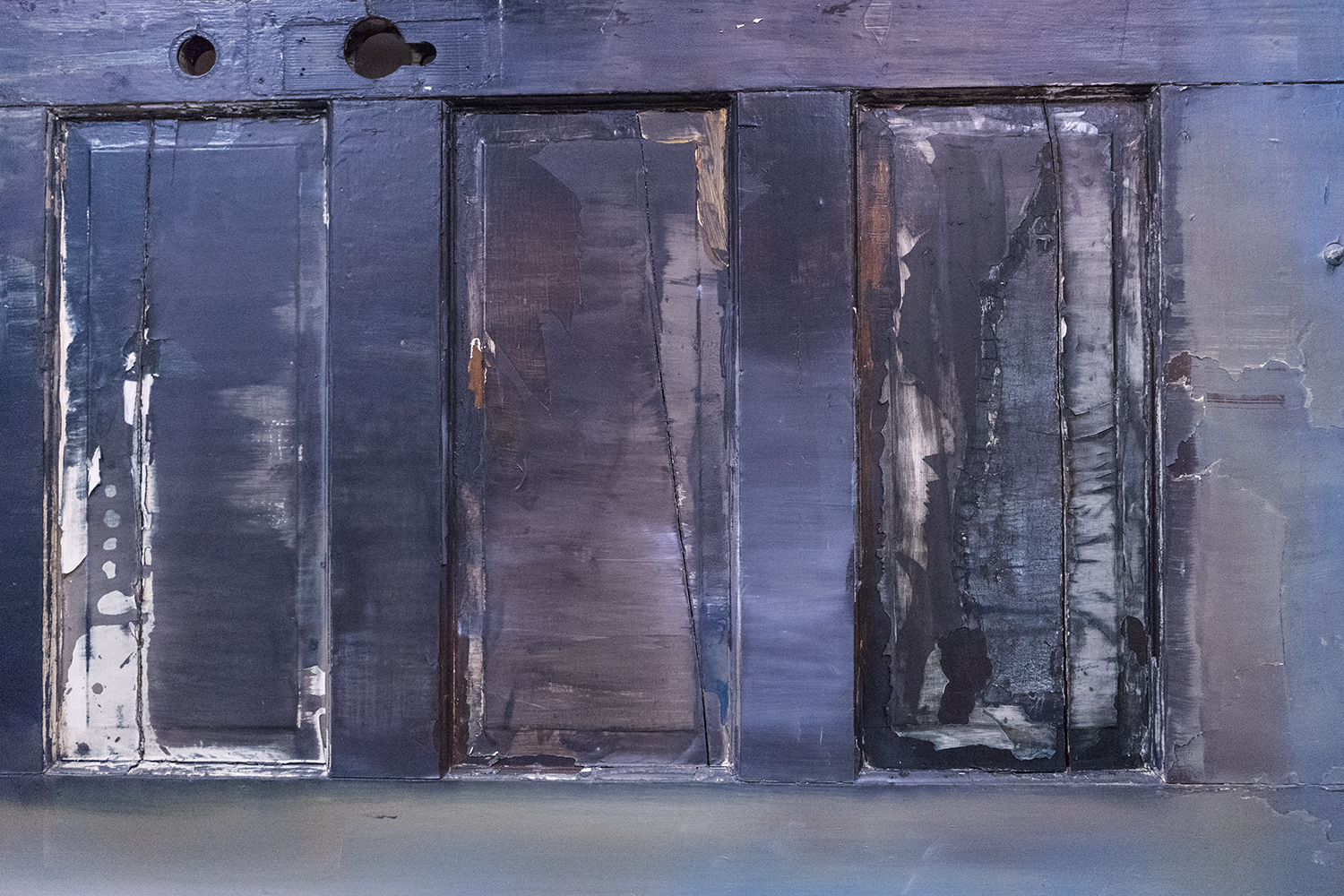
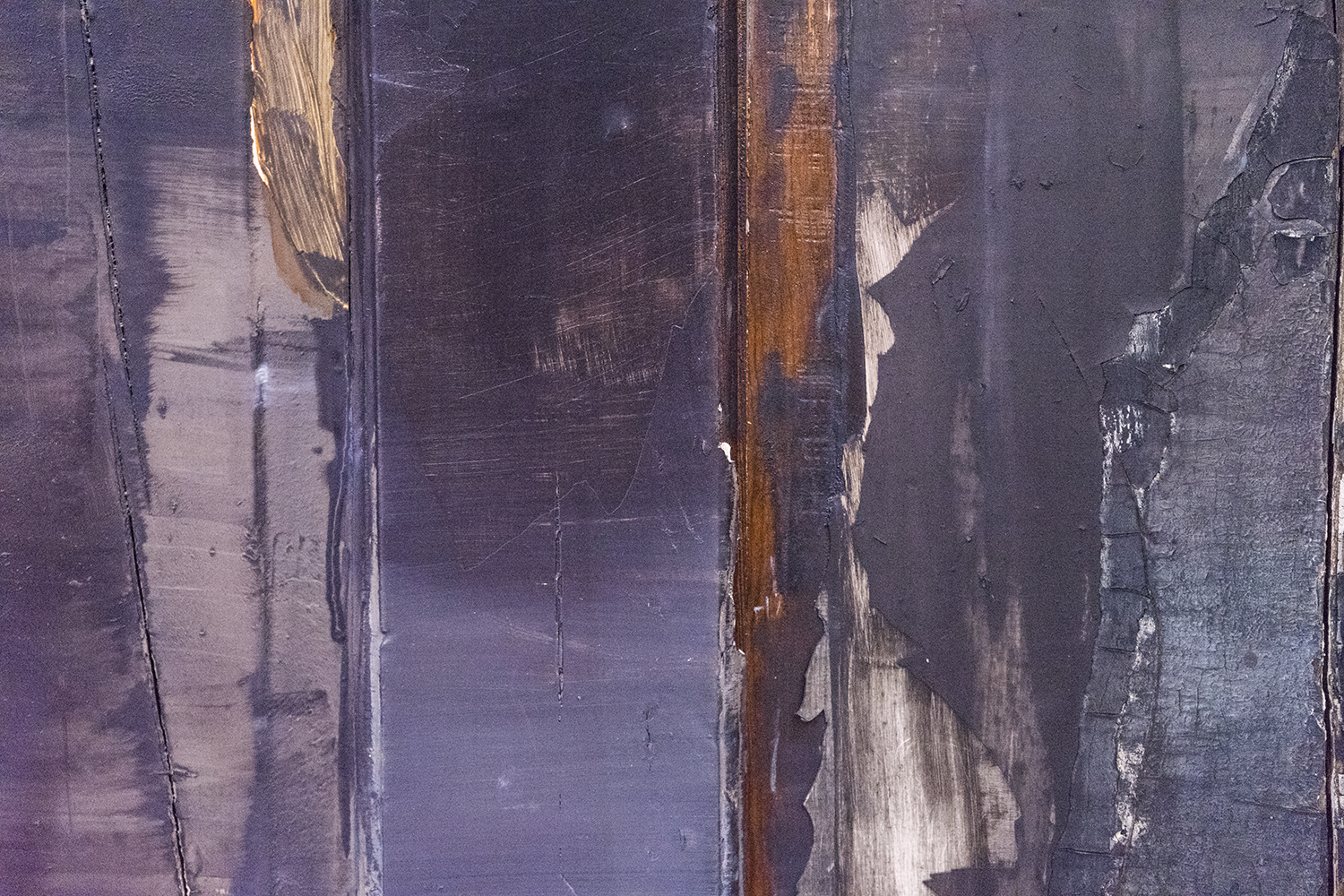
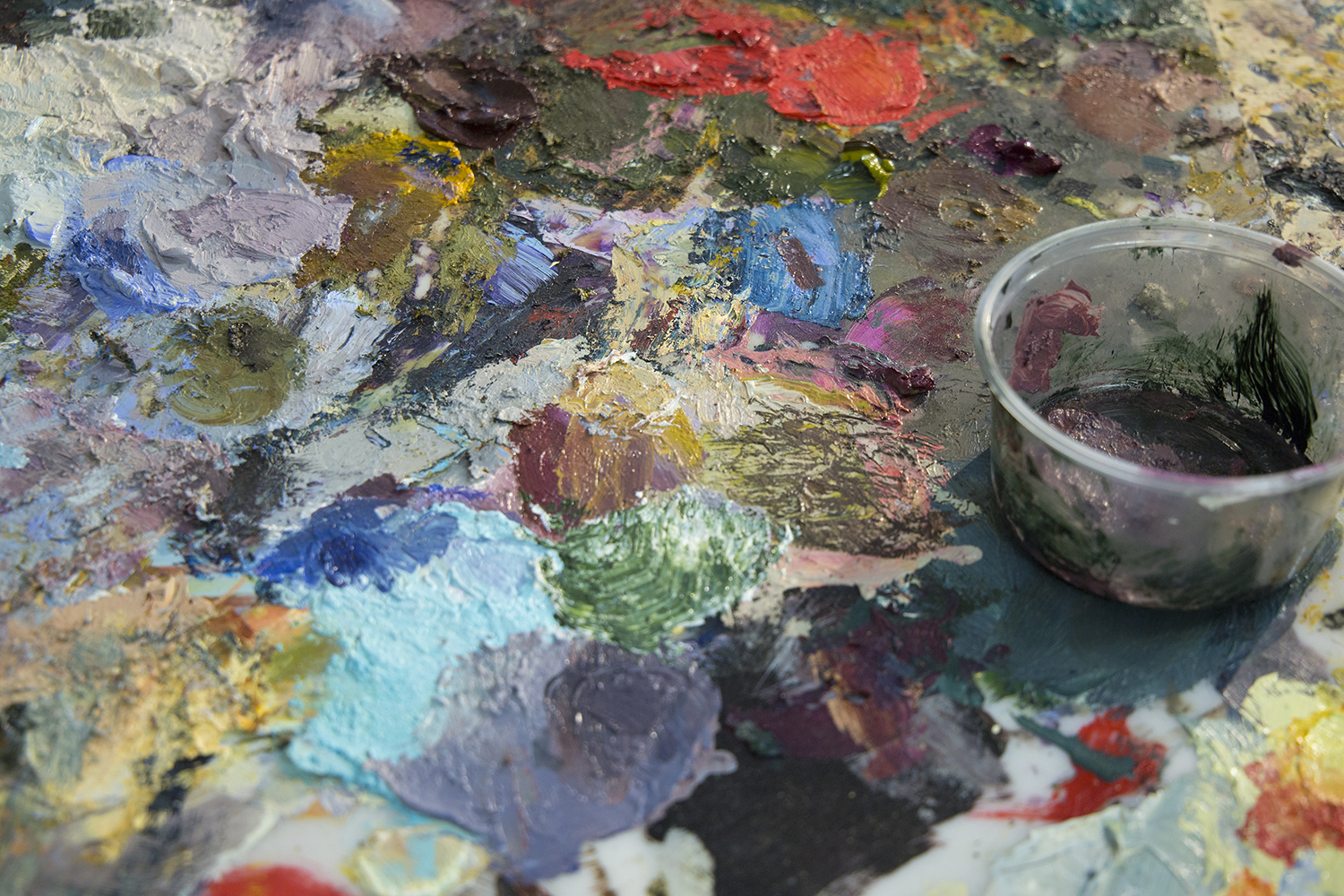
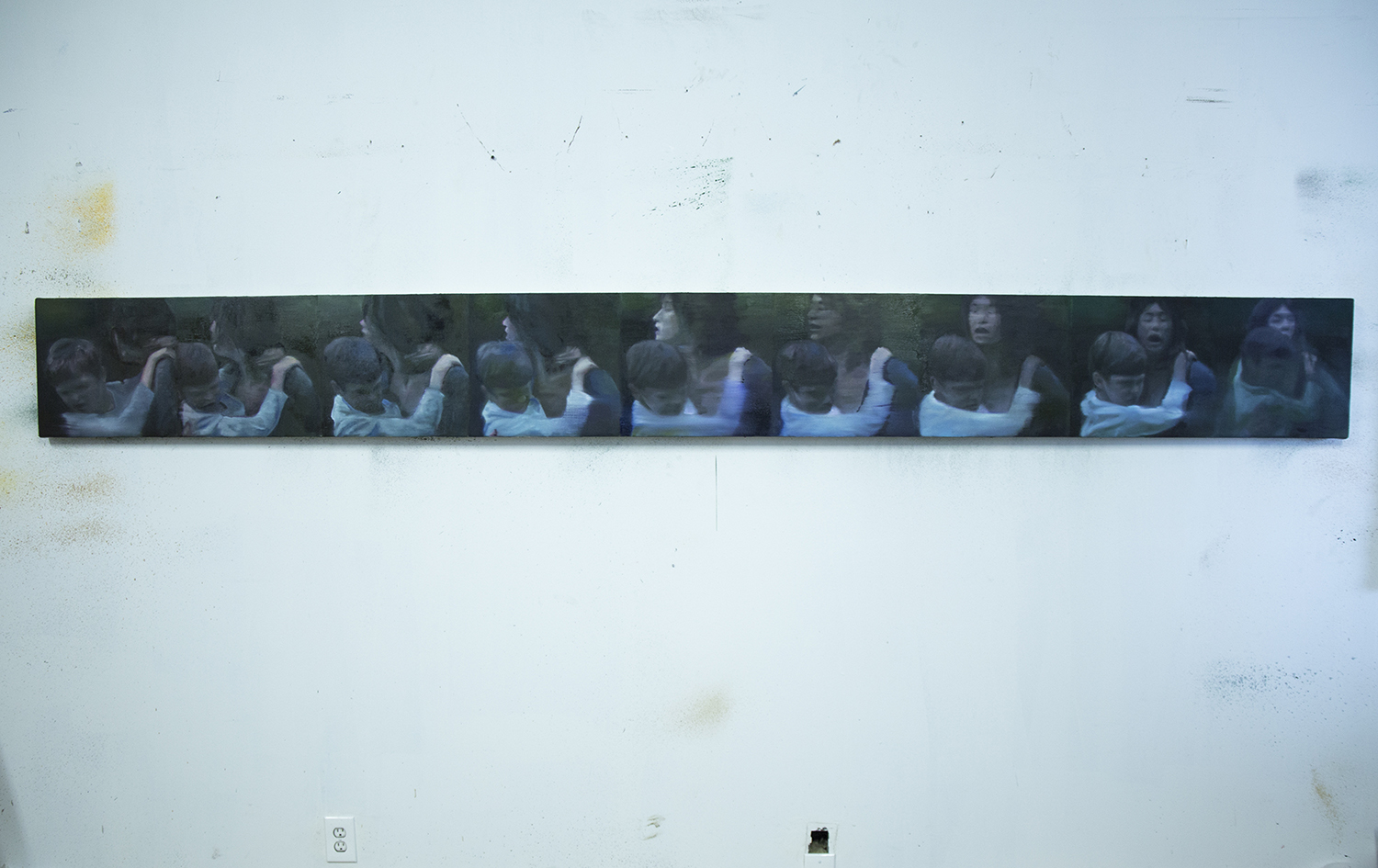
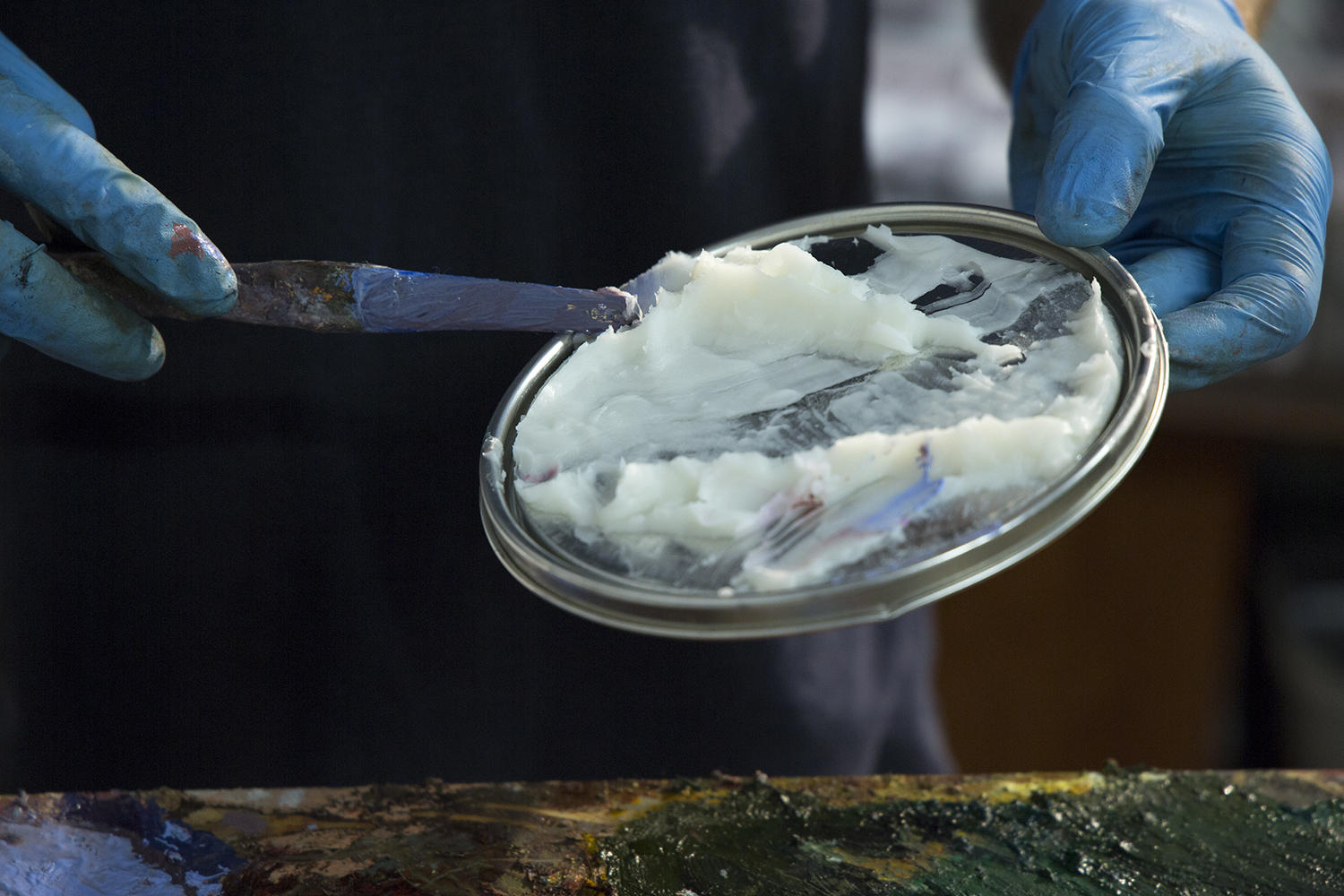
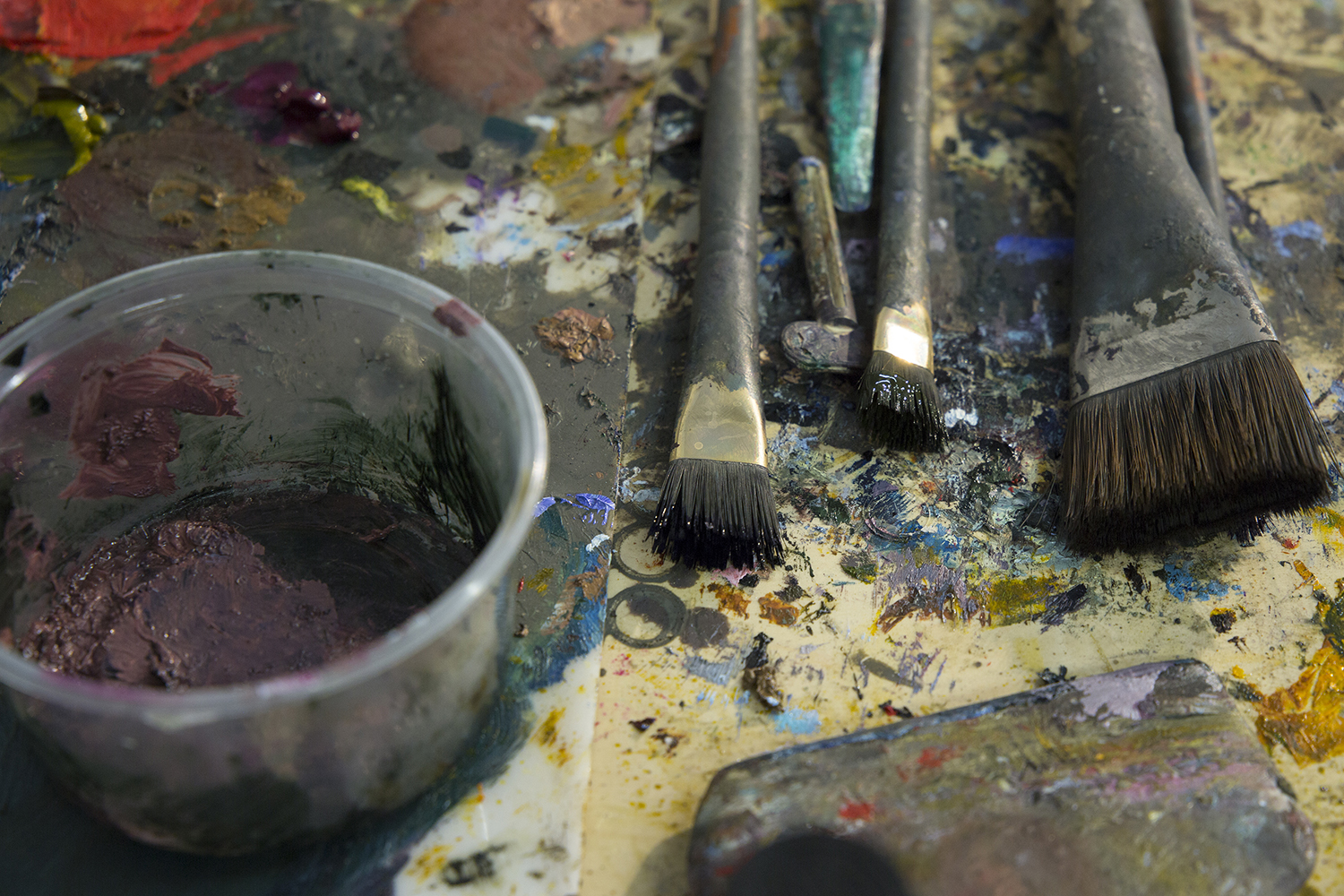
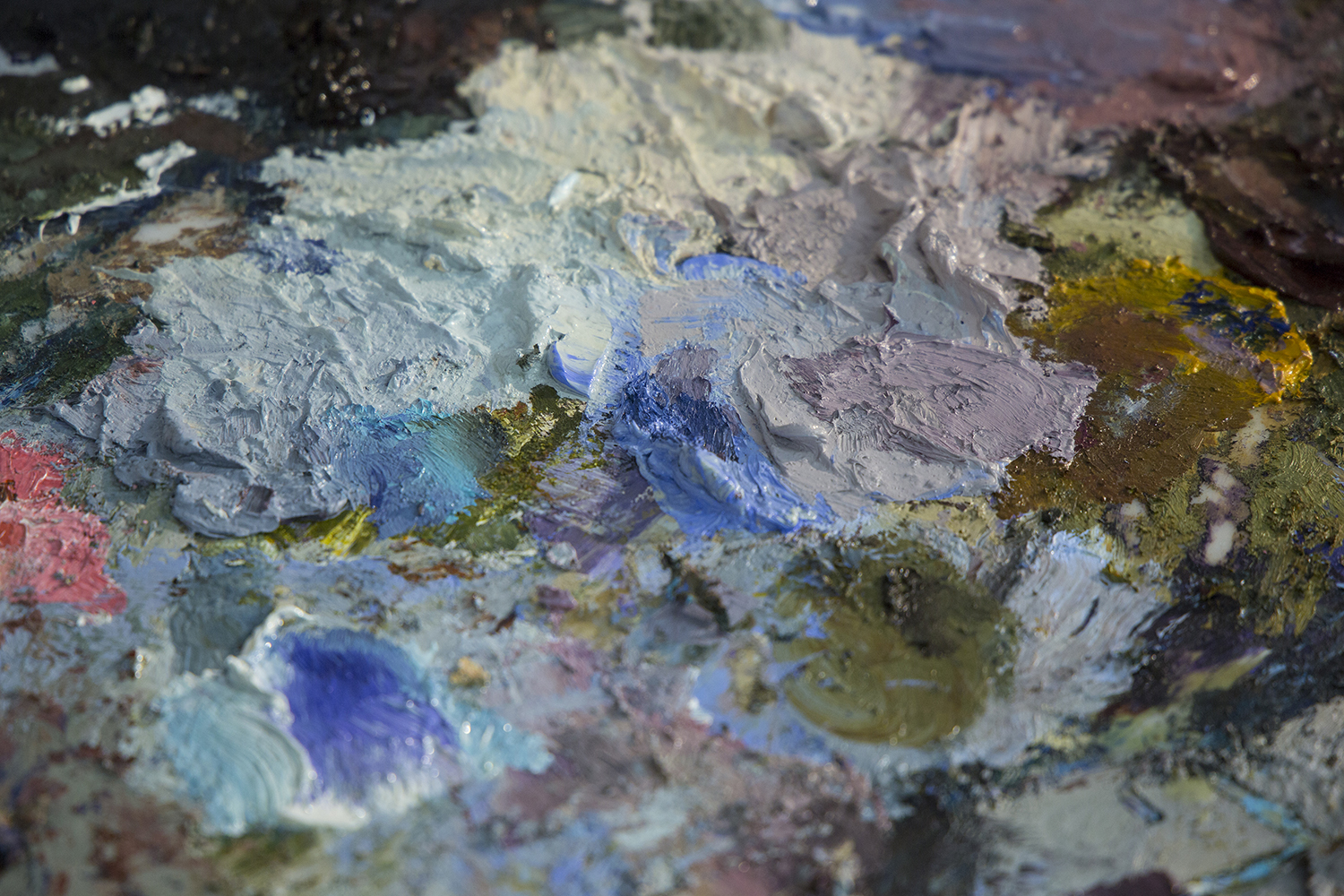
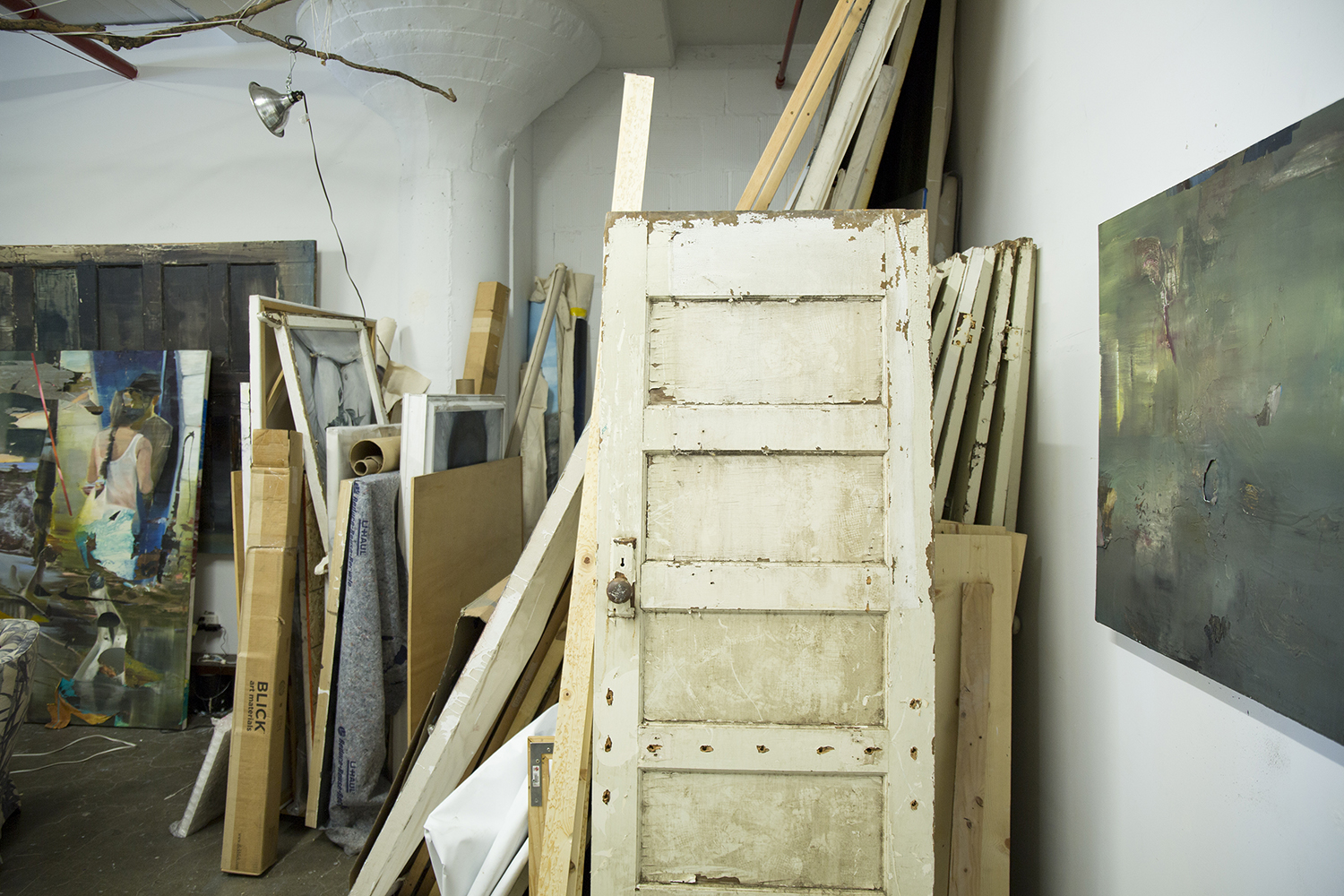
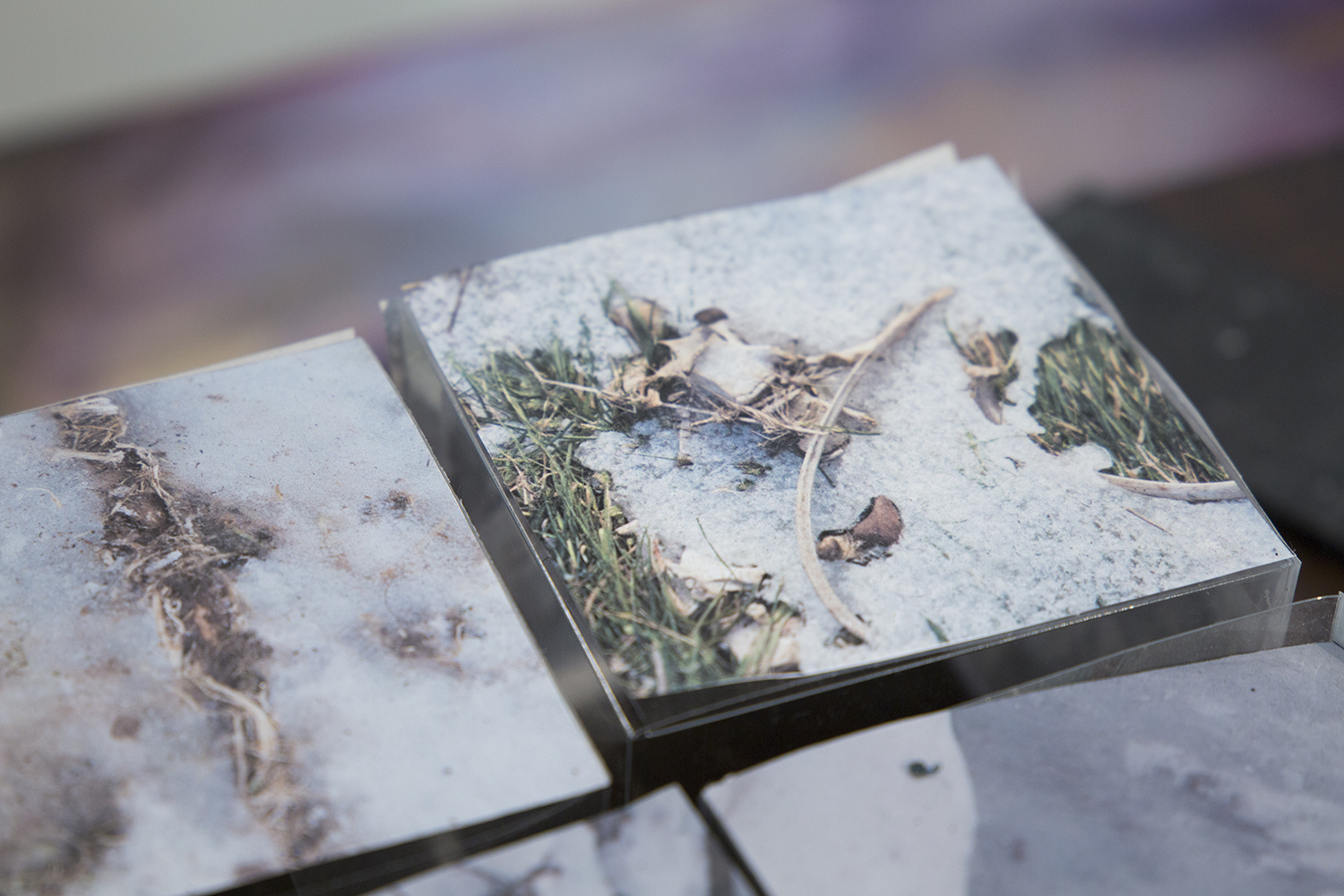
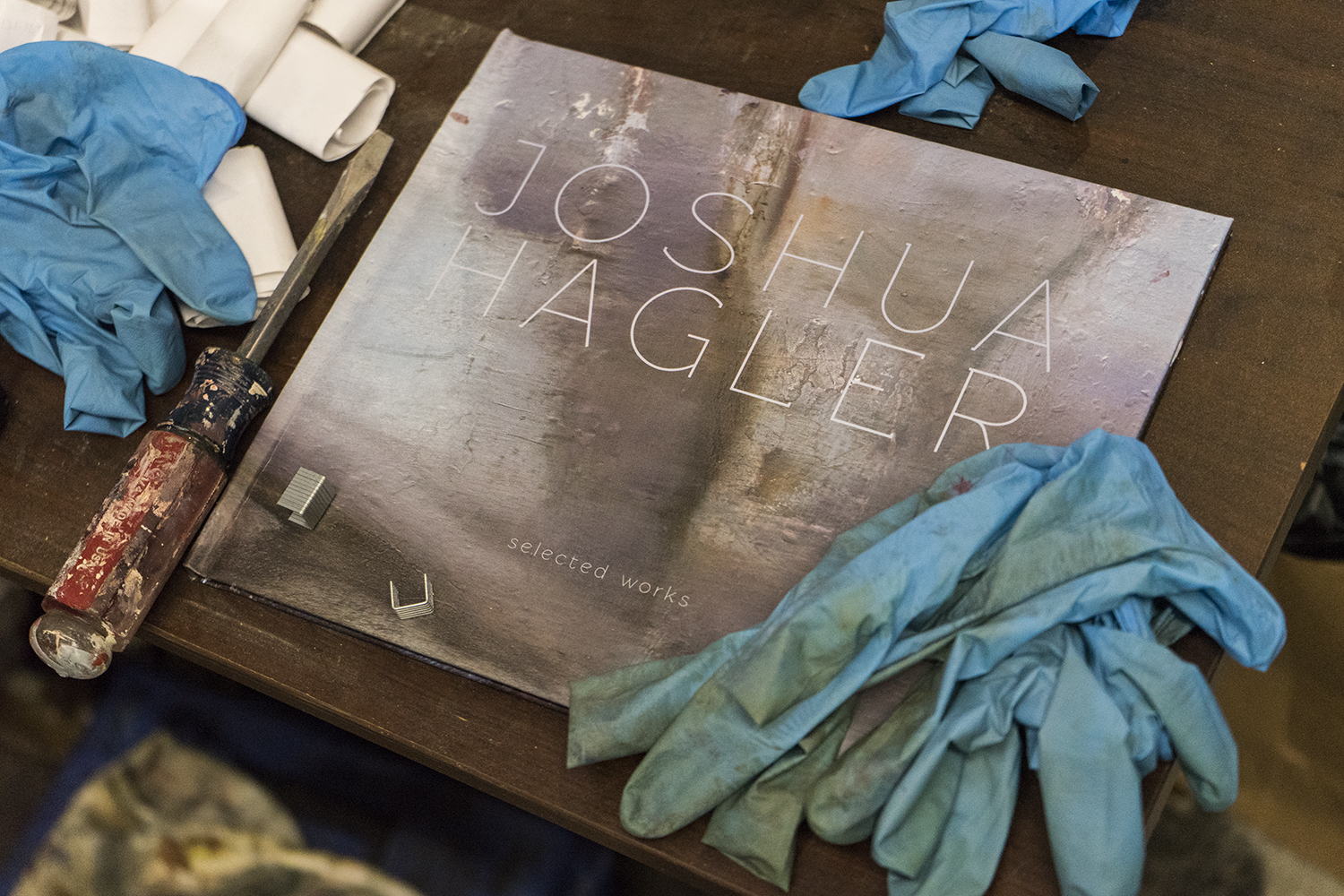

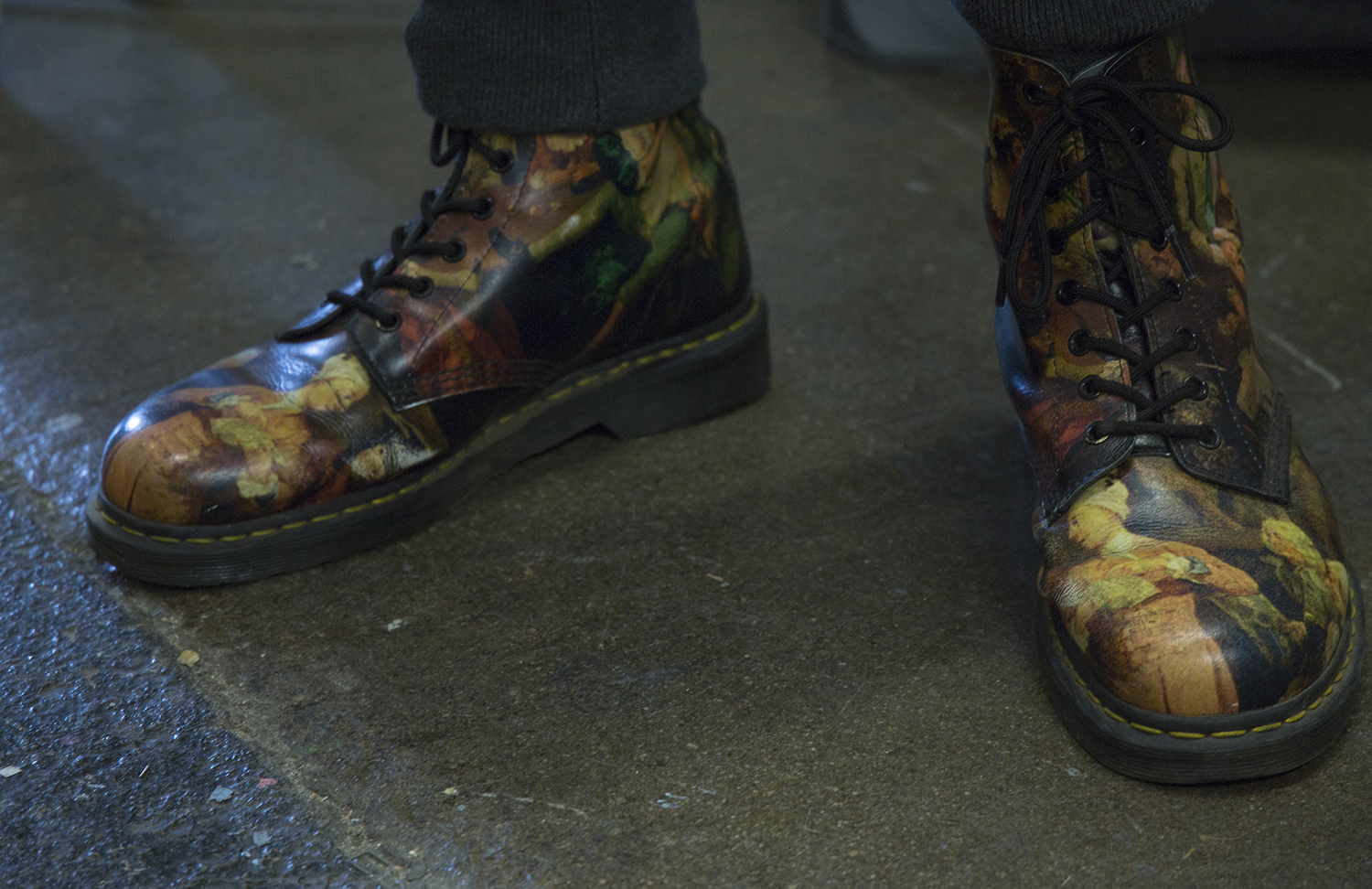
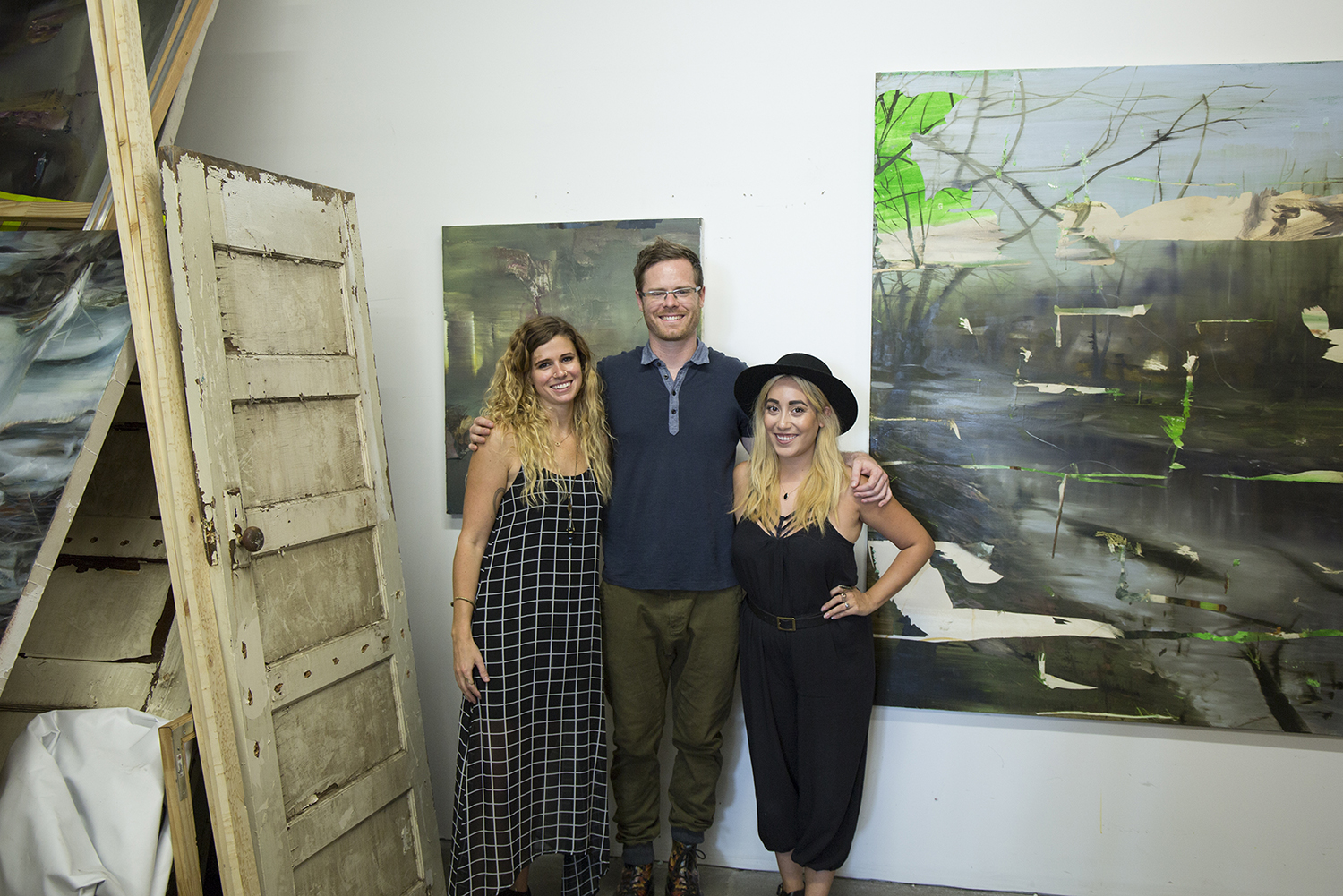
JOSHUA HAGLER
DOWNTOWN, LOS ANGELES
Walking into Joshua Hagler’s studio felt like entering one of those rooms from a sci-fi movie that houses multiple flickering portals, each inviting you to dive into other dimensions. You see these flashes of a distorted scene that feels so familiar, but you can’t quite make out if you dreamt it or once saw it in a movie. His paintings, gently resting against the walls, loom over you as a haunting tangle of figures and erased time spill out. (I come to find out later, that their inviting scale has been modeled perfectly to match two reposed doors.)
The thick smell of oil invites you closer to inspect these intimate moments where wet paint has been poured in to bind two moments, then scraped out to reconnect with layers underneath. Now that you’ve been pulled in close, you start to recognize the shapes: a horse leg, someone's left ear, a broken branch, a red coiled phone. The nostalgia makes you recognize that these portals seem to have the same current running through them. Having loved Josh’s work for a few years now I know that each painting has been thoroughly researched that he will likely be unpacking concepts in physics to help guide me through his portal chamber.
After moving from place to place as a child, Josh eventually landed in a Midwestern town with plenty of cornfields, one Walmart and one school, Litchfield, Illinois. Drawing and comics were Josh’s first method of time travel. He found his twin at school, Brandon. They were born on exactly the same day. Brandon was an expert at drawing castles and Josh was an expert at drawing people. So together they would populate imaginative landscapes. He shared with me that he grew up a nerd, with ten-hour role playing sessions much like the kids in the show Stranger Things. His unyielding academic reflection and attention to detail seem to be evidence of his former "nerddom." However, he continues to create new imaginative worlds, but instead of castles and clouds, it’s with American history and quantum physics. Josh received a BFA in Visual Communications and despite having a successful career and a graphic novel series, he decided to leave the design world to explore self-expression through painting. Attempting to condense what Josh has learned since then in a brief interview was near impossible, but I better let him lead you down the rabbit hole.
A MESSAGE ARRIVES FROM ACROSS THE RIVER, DETAILING A NUMBER OF STRANGE COINCIDENCES AND CHANCE ENCOUNTERS LEADING UP TO THIS MOMENT. IT CONCLUDES WITH A HEARTFELT METAPHOR ABOUT THE CLOSING AND OPENING OF DOORS. WHAT IS A DOORWAY, YOU THINK. WHAT IS A METAPHOR. YOU ALMOST FORGET TO WONDER WHO SENT IT. - (the exceptional title of the painting featured in the video above)
In one way or another, most of my ideas originate from my real-life experiences. This painting is a response to something that happened over three years ago. I received an email while watching the film Cloud Atlas, from somebody claiming to be my cousin. My uncle, who had died, never knew he had a son. This man lives in Independence, Missouri, which is the launching off point for all of the Westward Expansion from the early to mid-19th century. Among other things, he told me that he had just separated from his children’s mother and that he didn't know who his real father was until he was sixteen, after an incident in which he crashed his car. Only then did his mother tell him about my uncle since, coincidentally, my uncle had crashed the same car at the same age.
So I'm getting this email from a man who is essentially my same age, who lives in this place that I’ve already been researching, who actually turns out to be related to me, on the same night that my ex-wife moves out, all while I'm watching this movie play out multiple characters’ chance encounters.
So I start thinking about synchronicity.
A PECULIAR SET OF LITTLE RED MOON BOOTS
A Voice on the Line is really a piece made in memory of my youngest brother who died when I was a kid. It's really more about the way it's not spoken of in my family, so it's more about his absence, the unspoken memory, which is constantly present. We see the handset of a telephone, but we don't see the base, which appears in the painting, A Message Arrives From Across the River...
Inside the phone is a bluetooth earpiece, which plays sounds such as breathing in space helmets and old Western songs through my phone. So it's interactive. There is always a call for the viewer on the line. The boots sit in a perfectly square puddle of water that keeps its shape because of the superhydrophobic surfacing around the perimeter of the acrylic platform. It's lit form underneath much like the floor in 2001: A Space Odyssey. Around the platform are partially melted action figures, which coincidentally look reminiscent of snowy rocks. They were collected from the destroyed remains of my past sculptures.
For me, the natural law of the Black Hole is important here.
25. BLACK HOLE
Containing immeasurable mass and light it holds all that has ever approached it in its depths. At the bottom of a black hole, there is no time. No one can see inside, but from within, one can see the entire universe laid bare. Once entering its horizon, all that has ever been trapped inside rushes upward and all that will be trapped crashes down.
VISUALIZING QUANTUM ENTANGLEMENT
It is hard to talk about one of my paintings without referencing the others, because I'm leaving all of these bread crumbs as I make the work. There is always something intentionally left undone in one piece so that it can recur elsewhere. I'm borrowing the language of theoretical physics.
In the painting Hunter In The Snow I, I recreated a scene from the movie 2001: A Space Odyssey. My painting appears almost identical to the final scene in the film, except I’ve changed the painting on the wall behind the astronaut to Breugel’s Hunters in the Snow. Painted in 1565, it is possibly the world’s first painting about climate change. Europe, at that time, was getting colder and many people in Belgium were freezing or starving to death. I only included the left half of the painting because I've been interested in this idea of quantum entanglement, a phenomenon in physics in which two atoms set apart at great distances can be equally and simultaneously effected by simply interacting with one of them. The spooky implication is that an object can exist in more than one space at a time not because information can travel faster than the speed of light, but because information isn’t required to travel at all, possibly because both particles exist as one in a dimension outside of human perceptual bias.
I find poetic potentiality in the language of physics and the many possible ways it could be interpreted and visualized. One way that I’ve achieved that here is to reproduce the missing half of Bruegel’s Hunters In The Snow as the underpainting of another canvas called Lethe (Missouri River 1565, 1811, 2016). In this way, Lethe is entangled with Bruegel’s Hunters in the Snow. “Lethe” in Greek Mythology is a river in the Underworld causing any who drink from it to forget their past lives. By scraping out some painted areas and revealing small parts of Hunters in the Snow a memory starts to form but is never fully revealed. The work is entangled with the past even as the past is mostly forgotten. There are historical and political connotations in this gesture.
From Above the River Presses (Snake, December, 1811) mixed media on antique doors, LED bars, 60 x 80 in. 2016 : Photo from - http://joshuahagler.com/river
THE POWER OF WEIGHT AND LIGHT
In my painting, Hunter in the Snow you can see the figure is confronting something, but you don't know what it is. In cinema and on stage, there is the concept of the fourth wall, which invisibly exists in mutual faith between the performer and the viewer, demanding the performer to pretend not to see the audience or the camera, and providing a good safe distance from the action. Yet all action exists in anticipation of the viewer’s reaction, even as it seems to act independently of the viewer. Each is responsible for the reality of the other.
I wanted to make a physical fourth wall that captures the psychological weight felt within the image of Hunters in the Snow, so From Above the River (shown above) is the my representation of that. What's always been important to me in realism isn't skill, it's weight and light, which both pertain to the way that the universe is structured in terms of gravity and time. In this particular case, instead of giving something the illusion of having weight I’ve used antique doors to creating something that is actually very heavy. The light is physically present because I have installed LEDs that shine from either side. This might account for the illusion of light reflected in the helmet of the astronaut.
Although much of my past painting remains at least somewhat anchored in academic realism, I have always loved texture and frenetic gestures. As a constraint for this work, I wanted to do something more analytical, to separate the rendered from the textural. I make a lot of rules in the studio which I call natural laws, they govern the way that I handle the piece. So, in this case, the astronaut is completely rendered in a manner that is pretty faithful to the film still. Few brush strokes. Little texture. “Just tell the story,” I say to myself. The fourth wall is the opposite: all texture, all object, no story. If I felt like it in any delicate way then I had to stop. I had to feel more like I was forcing color on to it. I separated two opposites that usually exist in a single painting.
I have worked with doors in previous bodies of work. I like passageways, thresholds from one space to another. What's interesting is that when you turn doors on their side it almost gives the opposite impression from when they are upright. They feel like a wall that you can't pass through. It requires stillness rather than motion.
BEHIND THE SCENES
I have considered graduate school, mainly to ensure that there is no ceiling to my career. Also, even though it is slight, there seems to be a stigma around higher education, as if others wont take you as seriously. However, I have been making work full time for about a decade now. I come to the studio everyday. I don't think it is necessary to make that financial commitment am happy to explore that until it makes sense otherwise.
More recently, I’ve taken on a few classes as an adjunct professor. I felt so honored to be asked to teach, especially because I don’t have an MFA. I gain perspective from teaching and I become a lot more optimistic. It’s become important to me to balance studio activity with other things. If you're in the studio by yourself all the time, it's not the healthiest thing.
BREAKING THE BOX
There is market pressure on the artist to have this kind of repetitive consistency, an over-emphasis on style, and underemphasis of content or experimentation. I like to create psychological iterations on an underlying narrative that I have to embody in some way. Over the years I've had different ideas that bring me into different mediums and have had to find ways of pulling it off. It’s scary to take on something you’ve never tried before. I don't want to shy away from something because I think it won't be marketable or it wouldn't be good for my “branding.” I want to go toward projects and ideas that challenge both me and the viewer alike, even as those ideas grow away from painting.
Josh Hagler's pro tips:
Paint: Schmincke oil paints from the Blick website - very similar quality to Old Holland but better pricing.
Brushes: Monet Synthetic - surprisingly good quality from a non-natural hair and can be tossed after six months. For how clean Josh's paintings are, we were amused to find his can of dirty brushes.
